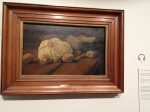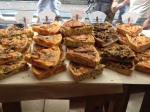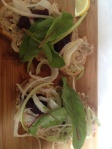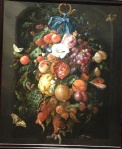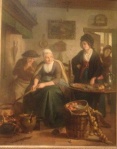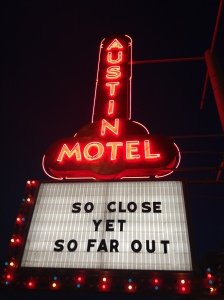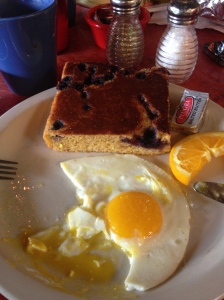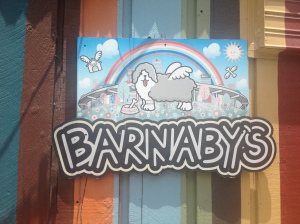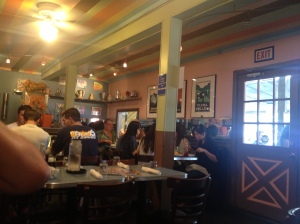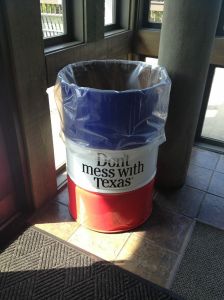
Tag Archives: Cityscape
Still Lifes: Amsterdam
Regeneration
Quick question: why is it that in Dublin, urban regeneration often involves knocking buildings down when old beauty could be brought back to life with new purpose?*
Dubliners, by birth or adoption, should begin to look up and look around. There is much treasure lining up the inner city. To wit, the beautiful Victorian fruit market in Little Mary Street currently used as a wholesalers market.
* I know, I know, it is all down to dastardly developers but isn’t a girl allowed to make a rhetorical question with aesthetic intent now and then?
The Great Depression
Live in a city, no matter how beautiful, and you will eventually have a bruise with ugliness. This may be the real difference, when all is told, between city and country dwelling. Nature offers shock and heartbreak but no cruelty or ugliness unless man is involved. Take Madrid, the city where I was born, a city, whose main thoroughfare, Gran Vía, will make your neck ache as you tilt it to spot another remote stone-faced hero crown an art deco or expressionist skyscraper; whose stunning Plaza de la Villa is a subtle example of unscripted harmony and charm; whose real cathedral, the Prado Museum, is an endless labyrinth of intelligence, feeling, and beauty. Take your pick of its beauties, and there are many, but inevitably you will lower your eyes down from the skyscraper and you will land on the prostrate maimed body of a heroin user begging for scraps with a cardboard sign under his stump. You will spot a grubby shop crassly advertising its gold-for-cash schemes to the unemployed or pension-less. You will see your reflection on the show-window of its best-known department store, offering a cornucopia of mediocrity to aimless souls such as yourself, for if the Prado Museum is Madrid’s heaven, El Corte Inglés must be its hell.
Yet, for me, there are no sadder uglier places in my native city than certain cafeterias established in the late seventies or eighties: places where function completely overrides pleasure, where banality rubs elbows with despair. They often belong to some autochthonous chain, sport the glaring lights of fast food joints but are as slow paced as traditional bars, have imitation rustic pine or formica furniture, display pictures of platters of food looking vaguely American and thoroughly unappetising, food that has had all the soul and life sucked out of it, a fried egg on top of a steak with some chips and limp lettuce on the side, say. Punters there are on the brink of being out of pocket, may have come into the city centre for their annual Christmas outing, women will wear boot cut jeans with some rhinestones along the pocket line, imitation leather ankle boots, pony tail held up mercilessly high; men have neatly ironed shirts tucked into their well-buckled trousers, a comb over, a signet ring. Conversations are reruns of a reality show or, at best, of the weather forecast. Whenever I walk past one of those cafeterias, I can hear an admonition not to lose my grip on life and its secrets as it unfolds; not to let go of clever goodhearted friends; to keep my eyes peeled and my ears open to beauty and truth wherever they lay hidden.
If you ever see me in one of those cafeterias, don’t walk on by, come to the rescue, tap on the glass, beckon me out onto the fresh air of another day.
Austin, the weird
The unofficial motto of our second destination in Texas, Austin, is “keep Austin weird”, a slogan reportedly coined by local community college librarian Red Wassenich, and his wife, Karen Pavelka, in response to what they felt was a “rapid descent into commercialism and over development”. It follows then, that any good Austinite will purport to keep his or her city “weird” not by, say, strapping a live duck to their chins and walking backwards reciting sections of the Book of Revelations in Klingon –undoubtedly a weird sight, but one that would hardly have an effect on the stultifying conformity of a corporate mass culture; but by continuing to support and sport alternative lifestyles as well as local individual businesses, keeping franchises at arms’ length and promoting the city’s unique culture through its business ventures.
The irony of the rapid descent into commercialism and uniformity of the “keep Austin weird” slogan when printed on an ubiquitous t-shirt notwithstanding, there is a salutary rebelliousness to the motto, refreshingly unburdened of the usual platitudes about the American can do spirit. To be weird is to be unique in a manner that may be disquieting to others and not hastened to be imitated. The motto suggests that Austin’s tradition is at odds with the Texan, even American tradition, and invites all potential rebel rousers and miscreants to enjoy the city’s famed tolerance. I consider myself a person with a healthily quirky disposition and have raised an eyebrow or two in my life time when voicing unexpected viewpoints. My life style, whilst not completely on the avant-garde of human behaviour, does not fit into the mold of the average person my age. Yet, upon arrival in Austin, I was crippled by the uncomfortable feeling that I was not weird enough, something that as a Madridian[1] I never thought I would experience. You see, being consistently, even persistently, weird is hard work. It is hard work to always be genuine, original and slightly odd. Now and then we all relax into a slouch of conformity by talking about the weather, having a Starbucks coffee or getting a mortgage. (In fact, just there I was thinking about getting a mortgage whilst having a Starbucks coffee.)
So we arrived in Austin and began our foray into weirdness very poorly by driving to the vicinity of 6th Street in the hopes of having a drink and maybe getting a whiff of some live music. If there is any city in the United States where we could have put our usually disconcerting pedestrian yearnings to good use in the service of enhancing our weirdness, that city is Austin. But no, we drove instead, just like anybody else. Austin had demonstrated just how weird it could get earlier by furnishing us with an extraordinarily good Mexican meal in an authentic Mexican restaurant –not Tex-Mex, you see– and this is how we repaid it. Driving into town. Like anybody else would.
I must say, though, that although we drove into town, something magical happened when we arrived, indeed something that you may call weird outside of Brooklyn: restaurants, bars, cafes, shops, you frigging name it, all stood within walking distance of one another. You could, for argument’s sake, get a burrito in one of the many food trucks parked in lots and sporting picnic tables, and then WALK to a cocktail bar for a slice of pie and a michelada for dessert, then take another few steps and stare at the wondrous and, indeed, weird, bric-a-brac in a vintage store and finally be blinded by the neon sign of a fifties motel. Just like that. One foot in front of the other in a matter of minutes: one small business after the next, mostly owned by the people who run them. Nobody need tell you about the secret cafes and bear bars that grace the remotest corners of suburbia like in Houston. Nobody had to tell us about the vegetarian café where I had one of the best breakfasts I have ever tasted in the shape of a perfectly fried egg, perfectly airy and moist slice of corn cake, perfectly pulpy freshly-squeezed orange juice and perfectly roasted coffee.
All was out in the open here. I have always liked a city that opens its arms to strangers. Weirdness can be beautiful like that.
[1] I have always been plenty weird in Madrid. I wonder what could become the unofficial motto of Madrid, what is there to preserve that is unique to its culture? “Keep Madrid noisy, polluted and a stronghold of PP” does not exactly roll off the tongue…
Houston, we have a problem
My first destination in Texas, Houston, gave me an unprecedented taste of urban space built to an American model that has no replica in Europe. Sure, I had experienced the dismally unnourishing ratio of restaurants/bars-to-people in Downtown Washington but the capital was still redolent of some Olde Worlde ideal in the fuck-off size of its Neoclassical public buildings. Downtown Houston, on the other hand, looks like a really boring financial district on steroids: skyscrapers, huge parking lots, no people anywhere in the evening. Actually, very few cars in view, now that you ask. Just huge tall buildings made of glass and various metals where an evil mastermind is plotting a second financial meltdown that will magically line his pockets and leave everybody else destitute.
The size of buildings and the blood-chillingly sterile feel of a place, however, are per se of no importance whatsoever to somebody driving into a city with an empty stomach at 9pm because as I have discovered in this trip nothing is important when your stomach is really empty after a really long drive. To wit: Your mother had a triple-bypass and also needs your kidney? Not important. Ethan Hawke -coincidentally a Texan– makes eyes at you and throws the keys to his house on your lap after shoving his current wife under a car? Not important. North Korea has nuked South Korea and is imminently going to nuke Houston where you are really hungry right now? Not important. So, really, clever(ish) observations about architecture, so NOT important.
Why do you make clever(ish) observations about architecture then? You may ask. The answer is that, as per the Washington example, urban planning gives you vital information about your chances of getting to a restaurant ON FOOT without being committed to a mental asylum or mistaken for a Depression-Era hobo carrying his clothes in a stinky bundle hanging from a stick. And if you have been in a car for about 10 hours, the last thing you want to do upon arriving at your destination is drive anywhere. And in Houston we just wanted to walk the twenty-odd minutes to a Mexican restaurant calculated by Google Maps. Only deserted streets that look like the lair of a twisted financial mastermind are unsettling and make you ask cops if you are walking in the right direction and the cops –echoing a widespread American sentiment– go “I would not walk there” deterring you from continuing your quest. Unfortunately you have not realised yet that the emphasis is on WALK and not THERE. You see, walking is something that only toddlers and New Yorkers do in the US. Everyone else has experienced walking only vicariously in poorly lit scenes in slasher films, where a teenager walks into a wood to find out what the heavy breathing is all about, or a lonesome traveller walks into a gruesome-looking den where somebody is fine-tuning something that sounds suspiciously like a chainsaw. And they saw them at a drive-in.
So in Houston, unwisely, we decided to turn around and find somewhere local. Nothing fancy, we thought. Fast food will do. A reasonably stocked grocery store will suffice. A two-day-old sandwich kept cool we will not refuse. Our minds were open. Our pockets had enough dough. Our feet enough vim. We were in a sincere “it will do” mood. Unfortunately there was nothing for us to tolerate, condescend, or even grit our teeth to, in the knowledge that it would make a really good anecdote back home. Nothing. Nada. Or as they say in Texas –or at least an annoyingly cartoonish Southern voice in my head– “darn tooting nothing, no siree.”
We would walk for a block and spot a neon sign in the distance and say to each other, “There it is, that’s where I am going to eat an undetermined foodstuff that will do!” only to have our hopes crushed upon discovery that it was a bail bond outlet. Trust me, after eight potential eateries are revealed to be garishly-lit bail bond outlets you do not exactly lose your will to live, but let’s say that you seriously consider holding somebody at knife point to get some food, since clearly, bailing or being bailed is a much easier thing for a pedestrian to do than eating in Downtown Houston. I may be in a detention centre somewhere in Houston right now if it were not because there was nobody to mug for food in the street and I would be easily out on bail by now. (Ok, I don’t carry a weapon either, but I was planning on a devastatingly withering remark.)
That night we went to bed hungry and frustrated. The following morning, our charming hostess –an artist living in a loft with an exquisitely stocked fridge that we did not dare to raid– after offering us coffee and breakfast, revealed all we needed to know about eating in Houston. First of all, the quest for an eaterie in the area was doomed from the start, there are none. Walking is, of course, viewed with suspicion and/or alarm. A Houstonian would have hopped in his/her car and driven to the restaurant. Presumably, those without cars are too pauperous to eat in a restaurant, so no point asking about their chances of fine dining. (In the interest of full disclosure, I am obliged to say that you can cycle in Houston as there is a public bike system.You could also take public transport to a destination in the vicinity, I guess.) To sum up, we wanted to walk to a restaurant and that was wrong, wrong, wrong.
She then recommended a place for brunch she frequents called Baby Barnaby’s. We could drive there in about 20/25 minutes, wait for a while to get a table as it is really popular and enjoy an excellent meal in a bright welcoming space before heading to Austin. That is exactly what we did, driving to a pleasant suburb in the outskirts of Houston where you can find Baby Barnaby’s in a clapboard residential-looking house across from a bear bar sportig a rainbow flag cross-pollinated with the Texan flag. The brunch was perfectly satisfying, not only because the food was excellent but because there were other people sitting in the same room, strangers at that, something that seemed in short supply in Downtown Houston. It was well worth the wait in 40 plus degrees in the sweletering sun.
If you know anything about the States you may realise that there is something a bit odd about this, admittedly bland, finale with pancakes and eggs. You may not bat an eyelid at the lack of restaurants in an office area, but surely you will find both a cafe and a bear bar in a residential area bizarre. Well, you are not wrong to raise an eyebrow, and the reason for this unusual mixture of subarban houses and commercial buildings lies in the fact that Houston is a zoning-free city: this means that you can build anything you want anywhere you want, provided it will be financially sound to do so. In theory you could erect, say, a chemical factory next to a residential estate, although in practice, strong private covenants tend to be enforced to prevent that kind of development in residential areas.
Supply and demand dictate construction in Houston, which explains why the particular Downtown area we stayed in had nothing but bail bond outlets, since that is what is in particular demand in the area (I am presuming there is some sort of detention centre nearby). Wtih few residents and fewer visitors wandering the streets at nightime looking for food, marketplace logic dictates that there will be no eateries. Cue my aimless ravenous hunger.
Lack of zoning also explains the intriguing presence of the much appreciated cafe and its gay-friendly counterpart in a neighbourhood where elsewhere you will only find picket fences and lawn sprinklers. Two places that lifted the spirit of an area that may otherwise have been dampened by the conformity and self-satisfaction of your typical American suburb.
Here I take the liberty to momentarily go back to my hostess’s loft downtown: a beautiful space filled with her art sporting a well-dressed library. During this trip I fancied myself in possession of Holmes-like powers of deduction when it came to various hosts’ life styles. A sure way to find out whether you can have a decent conversation with a stranger is to peruse their shelves: to see a beloved book or two on a stranger’s shelf is heartening and bodes well for the quality of the conversation you may enjoy. I was pleased to find out that our hostess had several books that were also sitting on my shelves in Dublin: although I had not met her yet (she had left instructions on how to get into the house and make ourselves at home) she was clearly talented and had excellent taste. My vanity directed me to the harmonious correspondence of art and literature in the loft and to the potential reflection of similar qualities in my character as the possessor of some of the same volumes. Alas, on the top shelf, I also found a book by Milton Friedman (of the Chicago School of Economics that so perniciously shaped the economy in the last few decades of deregulation) and a well-thumbed copy of Ayn Rand’s Atlas Shrugged (a book that has probably fed in equal measure adolescent fantasies of self-sufficiency and free market zealotry.)
It could, of course, be that she had those books on her shelves because she was well-read and wanted to keep her (literary and political) friends close and her enemies closer, but somehow I doubt it. They were displayed on the top shelves at eye-level for easy reach when standing up and Atlas Shrugged was lovingly worn out, like a teddy who has lost an eye because of a child’s too enthusiastic and frequent effusions.
When I finally met my hostess she was charming, intelligent, helpful and warm. I did not mention her books nor enquire about her politics. We did converse about education and, of course, urban planning, but we made vague noises in the general direction of good will and concern that even a seasoned Egyptologist may have found hard to decipher. The secret of harmony when conversing with strangers is not to avoid politics (which is impossible and also moronic) but to speak about problems, never about solutions. There are very few people out there who will profess a desire to see education standards decline, hordes of famished people in the streets, and environmental meltdown, but many will disagree on how to achieve desirable outcomes in those fields.
We did not broach our political leanings but I suspect that hers were a reflection of the mixture of free market endorsement and social tolerance that was evident in my limited but illuminating gastronomic adventures in Houston. On her shelves Rand rubbed elbows with Bedchel, Friedman with Spiegelman. On the streets of Houston, the foodless sterility of financial might with the unexpected culinary bounty of a socially inclusive suburb.
Don’t mess with Texas
Is politics determined only by the vote people put in the ballot box or can you take a place’s political pulse by the food they put in their mouths? Take Texas, for instance, a place best known for pint-sized big-breasted ladies lounging by their swimming pools (ok, this may just be the one time I managed to get an eyeful of Lucy Ewing in Dallas as a kid before my parents booted me back to bed, but you get the idea); or petrol gushing out of the soil in enormous sky-soaring spurts turning cowboys into oil tycoons thus generating a rivalry between fellow ranchers that will pinpoint important cross generational issues in an epic and somehow melodramatic storyline (ehem, this may be taken from the IMDB plot summary of ill-remembered James Dean vehicle Giant, but please look the other way and continue to believe that I know what I am talking about); nevermind, perhaps you know Texas as the place that gave intellectual wunderkind George W Bush his first shot at thwarting evil folk and stuff (this is taken from… shit, this is taken from reality. Gasp).
Ok, let’s face it. The truth is that neither you (particuarly you, European leftie type) nor I (also European leftie type) know nothing about Texas but I was there on my road trip for a grand total of three days, spoke to some good people, seemed to spend the majority of the time driving through enormous unpopulated expanses of land going “fuck, this is big” and peddling the oft-repeated “Texas is bigger than France but only has 25 million inhabitants” to my travelling companion enough times to make Cliff from Cheers blush, and stopped in a number of places to have widely differing eating experiences that, upon reflection, seem to say something or other about the diversity of the Lone Star state’s politics and culture. So here is my twopence. Oh, and don’t expect me to be so forthcoming about my ignorance anywhere else in the future.
(Clears throat.)
So…
Is politics determined only by the vote people put in the ballot box or can you take a place’s political pulse by the food they put in their mouths?
All will be revealed in my exposé about Texas, where I spent a grand total of three days imbibing and digesting the culture to an extent hitherto unimagined by super smart travellers covering impressively big expanses of land at lightning speed…
In our first instalment in this series our writer tries to eat in a Restaurant in Houston with intriguing results that will help our readers understand the Lone Star’s politics better and provide them with witty repartee!
Landscape, cityscape, foodscape: Ireland
A country is as much defined by the grand and exceptional as it is by the modest and familiar. Take Ireland, a place I know quite well: it may claim uniqueness for the precipitous drama of the blustery Cliffs of Mohair, the emerald monotony of the midlands, or its stark and soulful bog land. But I would contend that when it comes to its natural and/or vernacular landscape, there is as much Irishness in the stonewalls, berry bushes and minute wildflowers that you find in an unremarkable Irish country road.
Dublin, the city where I live, is sold to tourists for its Viking lineage, Georgian heritage, and the imposing fortress of learning that is Trinity College. There are other Dublins, of course: they are found in secluded parks that do their best to hide their charms from the masses; in erstwhile genteel buildings rubbing shoulders with second-rate Brutalist 1970s office blocks; in the effigies of Our Lady coffined in glass urns found in run down states.
There is an Irish landscape and an Irish cityscape. There is also an Irish foodscape. Some will only see it in the cluster of dine-with-design restaurants in the city’s hipster quadrangle (framed by South Great George’s Street/Fade Street/South William Street and Exchequer Street) and the organic weekend market in Meeting House Square in Temple Bar. Open your eyes wide and pay attention: you will also find it in the unselfconscious Indian and Chinese canteens and the hoarse-voiced women selling boxes of strawberries out of prams in down-at-heel Moore Street; or in the broken down elegance of the abandoned food market en route to Smithfield. Cannot see it yet? It is as much in the tottering boxes of bargain snacks in Aldi as in the wooden crates where spearmint, avocados, and aubergines jostle for space by the door of halal shops on Candem Street.
When it comes to the modest and vernacular, the Irish foodscape has a limited but subtle palette: the gold crust of a recently baked scone; the cinnamon swirl in a cup of tea; the peony smear of rhubarb on a plate; The exception: the arresting beauty of the white-crowned blackness of a pint of Guinness.






